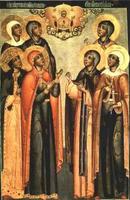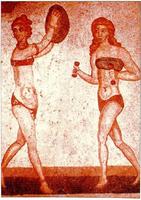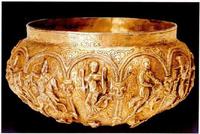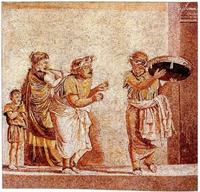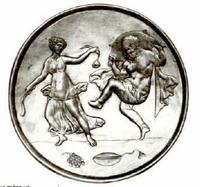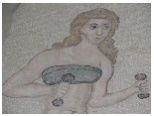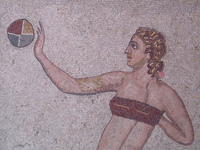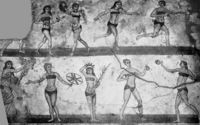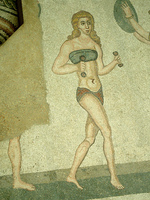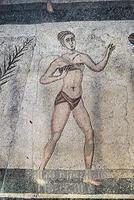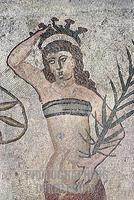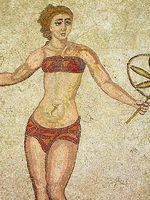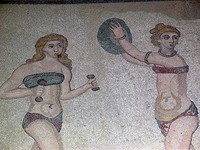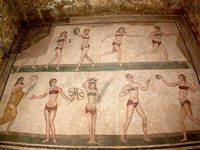WOMEN COMPOSERS IN BYZANTIUM
BY:
Diane Touliatos-Miles, Ph.D.
It is only in recent studies of Byzantine music that composers of medieval Byzantine chant have been examined. Not unlike composers of Western medieval music such as Leonin, Perotin, and Machaut, little is known about most Byzantine musicians. Nevertheless, renowned Byzantine musicians and composers of the late Middle Ages did exist, even though a majority of these musicians will forever remain only as names in the folios of the musical manuscripts. A few of the composers most frequently mentioned are Ioannes Koukouzeles, Ioannes Kladas, Xenos Korones, and Manuel Chrysaphes. As might be expected of medieval times, the composers from both the East and the West were predominantly men. However, women composers did exist.
From antiquity there was a legacy of Greek women composers. Although many of the women were hetairai (the highest class of prostitutes in ancient Greece), there were also respectable women, such as Pythia of Delphi; Telesilla of Argos; Sappho of Lesbos; Polygnota, daughter of Socrates of Thebes; and the daughter of Aristocrates of Cyme. A respectable woman musician was distinguished from hetairai by the occasional citation of her name and by the obligatory citation of her patronymic (father's name) and city of origin. The participation of respectable women performing and composing music was short-lived. The beginnings of Christianity brought great change to Greek culture. In the period of early Christianity in Byzantium, when men dominated all aspects of religious, political, and social philosophies, Byzantine women were considered to be intellectually and spiritually inferior to men.
It can only be surmised that the involvement of Byzantine women in music was minimal during the early centuries of the Empire. Because of its association with prostitution, performance on musical instruments was forbidden to young, unmarried women in the early period of Christianity. This attitude was obviously transmitted from the former role of the hetairai in Antiquity. Furthermore, women of all ages were forbidden to participate in any type of liturgical choir singing. (This attitude had been voiced by the apostle Paul to the Corinthian Greeks in I Corinthians 14:34-35.) Contrary to the position held by the early church, documentation proves that women did participate in congregational singing between the second and fourth centuries in such locales as Samosata, Syria, Jerusalem, and Edessa; this trend probably reached Byzantium as well.
Next to nothing is known about the role of women in liturgical music during the early centuries of the Empire. Most of our information on secular music in the early centuries of the Empire comes from the admonishments of the Church Fathers. In Byzantium we know that there was music for the accompaniment of theatrical performances and other public shows, ballets, and pantomimes in which women participated alongside men in song, dance, and instrumental performance. These activities are documented in chronicles by the Church Fathers who regarded them with contempt for all profane music. During these early centuries female musicians were referred to by the Church Fathers as prostitutes.
The Byzantine Empire existed for more than a thousand years, from its beginnings in the fourth century until its fall in 1453. Throughout this time, there were constraints on the participation of women in all aspects of life. Some of these constraints were legal edicts, while others were implied. From the ninth century until the end of the Empire, the Byzantines were unusually conservative in aspects of relations concerning women, leading to theseclu sion, or at the very least segregation, of women from men. For example, women of the Imperial court were known to be housed in private quarters of the palace away from the men; urban women who attended the large cathedrals of Constantinople were seated on the left side of the cathedral (facing the altar) to separate them from the men seated on the right side. It is from these centuries of constraint that very few names of Byzantine women composers-musicians have survived.
The Byzantine woman composer-musician is much harder to discover than her Western counterpart. In the area of secular music very little has survived and hence no names of women composers have been given. Manuscript sources of liturgical music have survived in great number, but anonymity was so honored in Byzantium that composers' names were often omitted, especially in early sources. For female composers, anonymity was perhaps observed in later periods as well, since they probably wished to be measured by the merit of their music and not by their gender. The absence of compositions attributed to or signed by women might also result from the reticence of Greek scribes. Throughout the Eastern and Western medieval periods, Greek scribes rarely included names or information about themselves. In Byzantium the women composers' names that have survived were associated exclusively with liturgical chant. These women were all literate and of middle- to upper-class social status. With the exception of one they were all nuns: Martha, mother of Symeon the Stylite; Theodosia; Thekla; Kassia; Kouvouklisena; and Palaeologina. The one for whom we have no knowledge is referred to as the daughter of Ioannes Kladas.
Of these women whose names are documented in sources as composers of Byzantine chant, only the music of Kassia and the daughter of Ioannes Kladas is preserved in manuscripts. Since music by only these two of the women hymnographers survives, one might ask whether the other women wrote music as well as the texts for their liturgical poems. Most of these female hymnographers were nuns who wrote their liturgical compositions for use in their nunneries. It is believed that these liturgical compositions were chanted, since liturgical rites were sung throughout in medieval Byzantium. Male Byzantine hymnographers, such as Romanos Melodos and John of Damascus, traditionally wrote both words and music. However, whether women composed their own music or employed contrafacta (preexisting music) is a point for debate.
The surviving information concerning the female composers is easily summarized. Martha was the mother of Symeon the Stylite, a Byzantine saint. Little is known about her: she lived toward the end of the ninth century and was the abbess of a nunnery at Argos. It is assumed that most of her musical works were composed for the nuns of her convent.
Theodosia, a devout abbess of a convent near the Imperial city of Constantinople, also lived during the ninth century. She is known for her composition of Kanons, a poetical form comprising nine odes and found in the Byzantine Morning Office known as Orthros. Another ninth-century composer is Thekla, who was also probably an abbess of a convent near Constantinople. Thekla has been described as a self-confident woman, proud not only of herself, but also of her sex. Her only surviving hymn is a Kanon in honor of the Theotokos (the Byzantine attribution for the Virgin Mary). Since this composition praises the Virgin Mary, it has also been called an encomium, or hymn of praise. In the millennium years of existence of the Empire, this Kanon is the only preserved hymn to the Theotokos by a woman. An examination of Thekla's literary skills in this complex Kanon attests to the fact that she was educated in literature as well as in Scriptures. In the several themes presented in the Kanon, the most significant is Thekla's premise that the Theotokos has emancipated Byzantine women from the guilt of Eve and has given women respect and honor in the Byzantine church. In addition to lauding the Theotokos, the woman most revered in Byzantium, Thekla shows her feminist traits by praising female martyrs, saints, and consecrated virgins of the Eastern Orthodox Church.
A later Byzantine woman musician is Kouvouklisena, a thirteenth-century precentor identified in Lavra MS Gamma 71, a manuscript in the largest monastery of Mount Athos. The citation in the manuscript pertains to the date of her death. More important, it identifies her as a domestikena or chantress and leader of a woman's choir. Although there were other female singers of chant, the acknowledgement of her musical role by a Greek male scribe from a monastery indicates her extraordinary vocal abilities and importance for the period. There is no clear indication that Kouvouklisena was a composer, but since many leading male precentors of the period were composers or at least arrangers of traditional chant, she also probably composed and improvised.
A Byzantine woman composer for whom we have a single musical reference is identified only as "the daughter of Ioannes Kladas." The sole musical composition and inscription in reference to this composer appears in Athens MS 2406, folio 258v. (A published musical transcription by this writer is available in College Music Symposium, volume 24, (Spring, 1984), p. 64.) The composer is identified by the patronymic and the relationship of the composer to the patriarch of the family, following the ancient Greek tradition of identifying respectable women. It is interesting that in the single reference to this female composer no given or Christian name is indicated. In instances where male members of a family are cited, a given name is usually included in addition to a family relationship. From this reference, it appears that the daughter of Ioannes Kladas was probably known as a singer and composer. Her fame, however, is not as great as that of her father, who was a leading composer of Byzantine chant of the late fourteenth century as well as "The Lampadarios" or maistor of the Hagia Sophia of Constantinople.
Based on the known lifespan of Ioannes Kladas, the composition by his daughter would have originated during the late fourteenth or early fifteenth century. The composition is included in a section of the manuscript that contains a collection of compositions by Ioannes Kladas. The selection attributed to the daughter is a memorial chant honoring the memory of her late father.
A later Byzantine woman hymnographer that might have lived in the fifteenth century is identified as Palaeologina. This hymnographer was obviously a well-educated, aristocratic woman from the Imperial family and dynasty Palaeologus that ruled from 1259 to 1453. Palaeologina is thought to have been a nun in one of the convents of Constantinople. It was for the convent that she composed Kanons, for which only the texts have survived.
The composer who is the most prominent woman composer and hymnographer in the history of Byzantine music and who has overshadowed the fame of other women composers of the Empire is Kassia. Kassia has the distinction of being the earliest woman composer for whom there is preserved music! She precedes her Western musical counterparts by over two centuries.
Much is known about Kassia, who was born around A.D. 810, probably in Constantinople, and died sometime between 843 and 867. Kassia is known by the various forms of her name found in manuscripts and service books: Kasia (Kasia), Kassia (Kassia), Eikasia (Eikasia), Ikasia (Ikasia), and Kassiane (Kassianh).
Over fifty liturgical chants are attributed to Kassia. (These musical compositions have been transcribed into Western staff notation by this writer and are available through Hildegard Press. ) As a gifted poet, Kassia wrote 261 secular verses in the forms of epigrams, gnomic verses, and moral sentences. Kassia's fame and importance is documented by Nikephoros Kallistos Xanthopoulos (a hymnographer and priest in the church of St. Sophia in Constantinople) in his fourteenth-century catalogue of important Byzantine hymnographers, in which she is the only woman composer acknowledged. Kassia is the only woman pictured in the frontispiece of a Triodion, a Lenten liturgical service book, printed in Venice in 1601, which also included pictures of the Byzantine churches leading hymnographers.
Kassia was from a wealthy family in Constantinople. Her father had the title of candidatos at the Imperial Court, which was a military title given to members of the aristocracy. Because of the honor given to her father, it is assumed that Kassia and her family were members of the Imperial Court. Like other aristocratic young girls of the court, Kassia, received a private education that was influenced by Classical Greek studies and which can be observed in her verse and writings.
During her teenage years Kassia became involved in the iconoclastic controversy of the Byzantine Empire. This was a controversy involving the use and abolishment of icons in churches. Kassia, along with other women, clergy, and monks, fought against the imperial edict abolishing the use of icons in churches. Because of her actions, Kassia was persecuted and lashed for helping imprisoned monks and iconodule exiles. It was during this time that Kassia also came under the influence of Theodore the Studite (759-826), abbot of the Studite Monastery of Constantinople, who was also a defender of icons. The correspondence between Kassia and Theodore the Studite reveals her inclination to become a nun, although he tried to dissuade her from such a decision so early in her life. Kassia also sent to Theodore examples of her writings, to which he responded with compliments on her literary skills.
Kassia's documentation in Byzantine chronicles and the popularity that has made her a legend in Byzantine folklore is a result of her participation in the bride-show of Emperor Theophilos, who reigned from 830 to 842. Bride-shows, in which the bride was selected in the ancient Greek classical manner, with a token of a golden apple, were very popular in Byzantium during the eighth and ninth centuries and were also used in oriental empires. The story of the beautiful noblewoman's participation in the bride-show for Theophilos (ca. A.D. 830) has been told many times, and there is proof and authentic documentation of the verbal exchange between Kassia and Emperor Theophilos. The earliest chronicler to have documented the incident is Simeon the Logothete of the tenth century. The following description of the incident was written by the historian Edward Gibbon.
With a golden apple in his hand he [Theophilos] slowly walked between two lines of contending beauties; his eye was detained by the charms of Icasia, and , in the awkwardness of a first declaration, the prince could only observe that in this world, women had been the occasion of much evil [in reference to Eve, the first created woman]; "And surely. Sir," she [Kassia] pertly replied, "they have likewise been the occasion of much good" [in reference to the Virgin Mary]. This affectation of unseasonable wit displeased the imperial lover; he turned aside in disgust; Icasia concealed her mortification in a convent, and the modest silence of Theodora was rewarded with the golden apple.
Kassia's pertinent and bold response to Theophilos was in defiance to the Byzantine tradition of silence and obedience to male supremacy. The Byzantine saying addressed to women was "Silence is an ornament." Kassia paid dearly for her boldness and quickness of wit by losing the opportunity to become empress. It is ironic that Theophilos's choice, Theodora, after the death of her husband, was the empress who restored icons, bringing the final end to the iconoclastic controversy.
In Byzantine society single women could not function easily and freely; as a result, the choices for proper women were either marriage or the monastery. Since Kassia had forfeited her chance to marry and become empress, she accepted the monastic life. In 843 she was said to have founded hew own monastery, named after her, on the seventh hill of Constantinople, the Xerolophos, near the Constantinian Wall. There she spent the remainder of her life as the abbess, composing music for the services in her monastery and writing her liturgical and secular verses.
Known mostly as a hymnographer and composer of sacred poems, Kassia was a comtemporary of the famous Byzantine composers, Theodore of Studite, Joseph of Thessalonika, and St. Theophanes. Her compositions were not acknowledged until recent times. Furthermore, besides composing music to her own liturgical poetry, Kassia also composed music to the poetry and prose of Byzantios, Georgios, Kyprianos, and Marcos Monachos.
Of the over fifty compositions attributed to Kassia, only about twenty-four are considered to be genuine compositions, while the remaining are of doubtful authorship. For the compositions that are of doubtful authorship, it is believed that the original melodies and texts of these were by Kassia but that other composers either embellished or varied her preexisting melodies with their own interpretation.
Most of Kassia's liturgical compositions are Stichera and performed in the evening and morning Office throughout the liturgical year. Although all of Kassia's compositions are notated monophonically, in accord with performance practice of medieval Byzantine liturgical music, it was usually sung by two choirs, one sang the monophonic notated melody, the other provided an unwritten improvisatory drone accompaniment called the isokratema.
Kassia's most famous musical composition which is still in use today is her troparion "The Fallen Woman," sung in the Morning Office of Holy Wednesday but technically celebrated at the end of the Vespers service of Holy Tuesday. This hymn is about Mary Magdalene, a "fallen woman," who washed Christ's Feet, anointed them, and wiped them with her long hair (St. Luke 7:36-50). The hymn is also considered to be in part autobiographical. Emperor Theophilos later regretted his decision not to choose Kassia as his bride, and he attempted to meet with her to express his sorrow and love. Although Kassia avoided him, in her heart she felt she had returned his love and had become a "fallen woman."
The melody and text of this hymn is by Kassia, but verse eight is attributed, according to legend, to Theophilos. Kassia was in the midst of writing this poem when the Emperor was making one of his unexpected stately visits to her monastery. Seeing Theophilos from afar, Kassia fled and left the poem on her desk. When the Emperor entered her monastery cell and saw her unfinished poem, he added the lines:
The feet whose sound
Eve heard in Paradise
In the afternoon
And hid in fear.
After his departure Kassia returned to complete her poem and found the addition with its double meaning: Eve hiding from God, or Kassia hiding from Theophilos. Although out of context with the theme of a fallen woman, Kassia retained the Emperor's addition. It is this legendary element that has made this hymn so well known.
The next most popular hymn of Kassia's after "The Fallen Woman" is her famous sticheron idiomelon doxastikon "Augustus, the Monarch."
In this picture you see Kassia's "Augustus, the monarch" as it appears in a musical manuscript. On the lower right corner of the manuscript, you can see the attribution to Kassia. This melody was so well known during Byzantine times that it was documented in the chronicles of Byzantium. This hymn was sung during the Vespers service of December 25th, for it glorifies the birth of a new King, Jesus Christ. In this hymn Kassia displays her genius as both a poet and musical composer, for the text interweaves and influences the structure of the melody. In the text Kassia parallels and contrasts the reign of the first Roman Emperor Augustus (27 B.C. -A.D. 14) with the rule of Jesus Christ. Besides the parallelism of the themes, there is a parallel metrical rhyming scheme in the text that corresponds to the parallelism in the music. The sequential structure of this sticheron has led some scholars to believe that the sequence was brought from Byantium to the West.
Kassia's over fifty musical compositions exhibit her talent and originality as a poet and an a composer. Her poetry guides the structure of her musical compositions. Her compositions are far more original than most of her contemporaries'; otherwise, her music might not have been documented in the Byzantine chronicles of the time. Most hymnographers of the period were far less imaginative; their poetry was more verbose and their compositions longer. They gave little attention to musical structure. Kassia's music is concise; her texts set syllabically. Her musical inventiveness and wit is demonstrated by the form of her compositions, which often parallels or contrasts with the text; in musical motives that symbolize and reflect the text (an early use of tone painting); and in her poetic play with words. Furthermore, Kassia is historically important as the only hymnographer who wrote a penitential hymn on the "fallen woman," Mary Magdalene, a subject that no male hymnographer deemed worthy of attention.
These few names of women composers in Byzantium is evidence of women who contributed to the culture of music. Since the participation of women in secular music was condemned, respectable women, with no other outlet for musical participation, turned to sacred music and created new works for the nunneries of Byzantium. These convents served as cultural retreats for those aristocratic, wealthy, and educated women who did not marry. It was for the convents of Byzantium that the few known women composers and hymnographers wrote their compositions, to be chanted in liturgical services by their female peers. Some of these, such as Kouvouklisena, possessed outstanding vocal abilities that were admired by their male counterparts-an extraordinary measure of success. There is no doubt that the convents were centers for much musical activity and productivity by Byzantine women. However, few of the typika from nunneries have survived. More importantly, misogyny taints much of the documentation of Byzantine women's participation in music. Women were measured by the standard Byzantine phrase: ] Ivm=hn de p`antos kef`alhn t=hs gunaik-os ton }andra ["Ismen de pantos kefalin tes gynaikos ton andra"] (Women are always under the head of the man).
Bibliography
Touliatos, Diane. "Kassia (ca. 810-ca.867)," Women Composer: Music Through the Ages, vol. I Composers Born Before 1599, eds.Martha Furman Schleifer and Sylvia Glickman. New York: G.K. Hall,1996, pp. 1-24.
Idem., "The Traditional Role of Greek Women in Music from Antiquity to the End of the Byzantine Empire," Rediscovering the Muses: Women's Musical Traditions, ed. Kimberly Marshall (Boston: Northeastern University Press, 1993), pp. 111-23 and notes 250-53.
Idem., "Medieval Women Composers in Byzantium and the West," Proceedings of the VIth International Congress of Musicology "Musica Antiqua Europae Orientalis" (Bydgoszcz, Poland, 1982) pp. 687-712.
Idem., "Women Composers of Medieval Byzantine Chant," College Music Society Symposium, vol. 24, pt. 1 (Spring, 1984), 62-80.
Kassia's "Using the Apostate Tyrant As His Tool," Transcription and Arrangement by Diane Touliatos for the Kronos String Quartet's Early Music (Lachrimae Antiquae) CD, 3' 51", released September, 1997.
The Author




